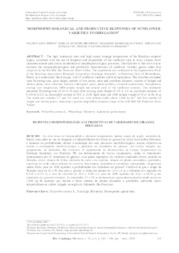Morphophysiological and productive responses of sunflower varieties to irrigation.
Morphophysiological and productive responses of sunflower varieties to irrigation.
Author(s): SIMOES, W. L.; DRUMOND, M. A.; OLIVEIRA, A. R. de; GONCALVES, S. L.; GUIMARÃES, M. J. M.
Summary: The high luminosity rates and high annual average temperatures of the Brazilian semiarid region, combined with the use of irrigation and adaptability of the sunflower crop to local climate, favor increased achene yield due to acceleration of morphophysiological processes. The objective of this work was to evaluate the morphophysiological and productive characteristics of sunflower varieties grown under drip irrigation in the Sub-Mid São Francisco River Valley. The experiment was conducted in the Experimental Field of the Brazilian Agricultural Research Corporation (Embrapa Semiarid), in Petrolina, State of Pernambuco, Brazil, in a randomized block design, with 21 sunflower varieties and four replications. The variables evaluated were flowering time, plant height, number of live leaves, stem and capitulum diameter, number of lodged and broken plants, stem curvature, relative chlorophyll index, photosynthesis, stomatal conductance, transpiration, average leaf temperature, 1000-achene weight and achene yield of the sunflower varieties. The treatments presented flowering time of 43 to 59 days after sowing, plant height of 1.0 to 1.4 m, capitulum diameter of 0.154 to 0.221 m, chlorophyll content of 30.8 to 33.98 Spad units and 1000-achene weight of 35.61 to 80.30 g. The sunflower varieties V7 and V8 stood out, with achene yields above 2,960 kg ha-1 and low number of lodged and broken plants, indicating a greater adaptability irrigation crops in the Sub-Mid São Francisco River Valley.
Publication year: 2018
Types of publication: Journal article
Unit: Embrapa Semi-arid Region
Observation
Some of Embrapa's publications are published as ePub files. To read them, use or download one of the following free software options to your computer or mobile device. Android: Google Play Books; IOS: iBooks; Windows and Linux: Calibre.
Access other publications
Access the Agricultural Research Database (BDPA) to consult Embrapa's full library collection and records.
Visit Embrapa Bookstore to purchase books and other publications sold by Embrapa.

